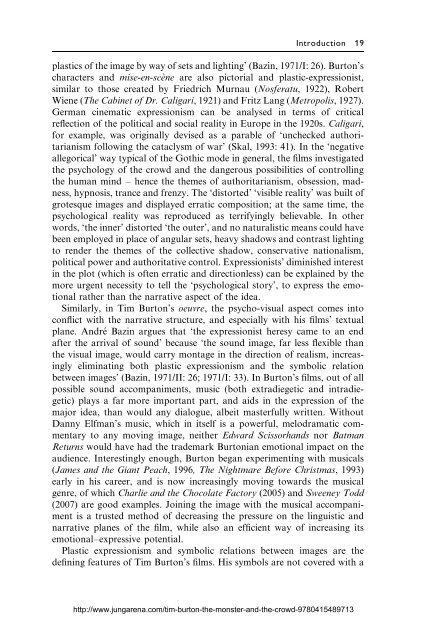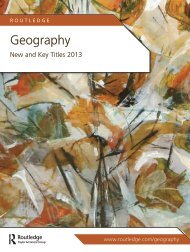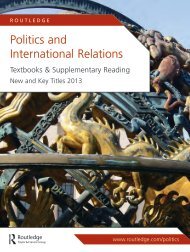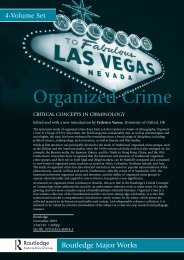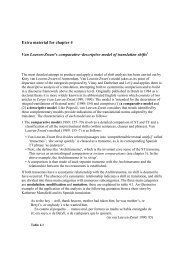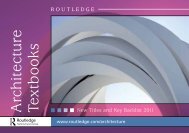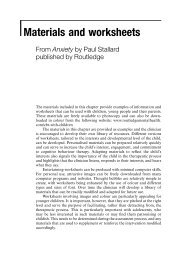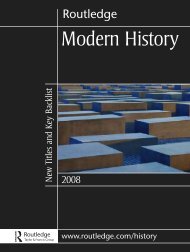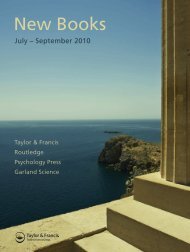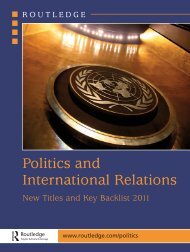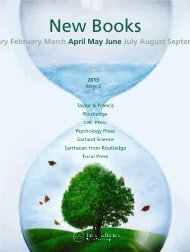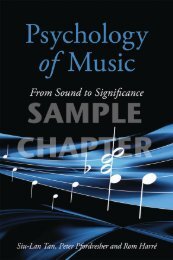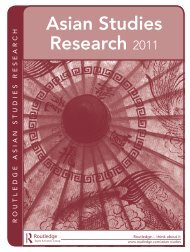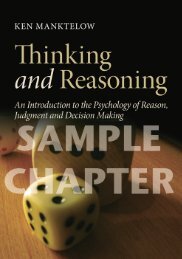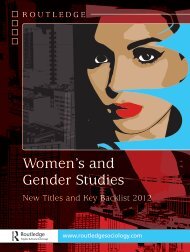Tim Burton: The Monster and the Crowd - A Post-Jungian Perspective
Tim Burton: The Monster and the Crowd - A Post-Jungian Perspective
Tim Burton: The Monster and the Crowd - A Post-Jungian Perspective
You also want an ePaper? Increase the reach of your titles
YUMPU automatically turns print PDFs into web optimized ePapers that Google loves.
Introduction 19<br />
plastics of <strong>the</strong> image by way of sets <strong>and</strong> lighting' (Bazin, 1971/I: 26). <strong>Burton</strong>'s<br />
characters <strong>and</strong> mise-en-sceÁne are also pictorial <strong>and</strong> plastic-expressionist,<br />
similar to those created by Friedrich Murnau (Nosferatu, 1922), Robert<br />
Wiene (<strong>The</strong> Cabinet of Dr. Caligari, 1921) <strong>and</strong> Fritz Lang (Metropolis, 1927).<br />
German cinematic expressionism can be analysed in terms of critical<br />
re¯ection of <strong>the</strong> political <strong>and</strong> social reality in Europe in <strong>the</strong> 1920s. Caligari,<br />
for example, was originally devised as a parable of `unchecked authoritarianism<br />
following <strong>the</strong> cataclysm of war' (Skal, 1993: 41). In <strong>the</strong> `negative<br />
allegorical' way typical of <strong>the</strong> Gothic mode in general, <strong>the</strong> ®lms investigated<br />
<strong>the</strong> psychology of <strong>the</strong> crowd <strong>and</strong> <strong>the</strong> dangerous possibilities of controlling<br />
<strong>the</strong> human mind ± hence <strong>the</strong> <strong>the</strong>mes of authoritarianism, obsession, madness,<br />
hypnosis, trance <strong>and</strong> frenzy. <strong>The</strong> `distorted' `visible reality' was built of<br />
grotesque images <strong>and</strong> displayed erratic composition; at <strong>the</strong> same time, <strong>the</strong><br />
psychological reality was reproduced as terrifyingly believable. In o<strong>the</strong>r<br />
words, `<strong>the</strong> inner' distorted `<strong>the</strong> outer', <strong>and</strong> no naturalistic means could have<br />
been employed in place of angular sets, heavy shadows <strong>and</strong> contrast lighting<br />
to render <strong>the</strong> <strong>the</strong>mes of <strong>the</strong> collective shadow, conservative nationalism,<br />
political power <strong>and</strong> authoritative control. Expressionists' diminished interest<br />
in <strong>the</strong> plot (which is often erratic <strong>and</strong> directionless) can be explained by <strong>the</strong><br />
more urgent necessity to tell <strong>the</strong> `psychological story', to express <strong>the</strong> emotional<br />
ra<strong>the</strong>r than <strong>the</strong> narrative aspect of <strong>the</strong> idea.<br />
Similarly, in <strong>Tim</strong> <strong>Burton</strong>'s oeuvre, <strong>the</strong> psycho-visual aspect comes into<br />
con¯ict with <strong>the</strong> narrative structure, <strong>and</strong> especially with his ®lms' textual<br />
plane. Andre Bazin argues that `<strong>the</strong> expressionist heresy came to an end<br />
after <strong>the</strong> arrival of sound' because `<strong>the</strong> sound image, far less ¯exible than<br />
<strong>the</strong> visual image, would carry montage in <strong>the</strong> direction of realism, increasingly<br />
eliminating both plastic expressionism <strong>and</strong> <strong>the</strong> symbolic relation<br />
between images' (Bazin, 1971/II: 26; 1971/I: 33). In <strong>Burton</strong>'s ®lms, out of all<br />
possible sound accompaniments, music (both extradiegetic <strong>and</strong> intradiegetic)<br />
plays a far more important part, <strong>and</strong> aids in <strong>the</strong> expression of <strong>the</strong><br />
major idea, than would any dialogue, albeit masterfully written. Without<br />
Danny Elfman's music, which in itself is a powerful, melodramatic commentary<br />
to any moving image, nei<strong>the</strong>r Edward Scissorh<strong>and</strong>s nor Batman<br />
Returns would have had <strong>the</strong> trademark <strong>Burton</strong>ian emotional impact on <strong>the</strong><br />
audience. Interestingly enough, <strong>Burton</strong> began experimenting with musicals<br />
(James <strong>and</strong> <strong>the</strong> Giant Peach, 1996, <strong>The</strong> Nightmare Before Christmas, 1993)<br />
early in his career, <strong>and</strong> is now increasingly moving towards <strong>the</strong> musical<br />
genre, of which Charlie <strong>and</strong> <strong>the</strong> Chocolate Factory (2005) <strong>and</strong> Sweeney Todd<br />
(2007) are good examples. Joining <strong>the</strong> image with <strong>the</strong> musical accompaniment<br />
is a trusted method of decreasing <strong>the</strong> pressure on <strong>the</strong> linguistic <strong>and</strong><br />
narrative planes of <strong>the</strong> ®lm, while also an ef®cient way of increasing its<br />
emotional±expressive potential.<br />
Plastic expressionism <strong>and</strong> symbolic relations between images are <strong>the</strong><br />
de®ning features of <strong>Tim</strong> <strong>Burton</strong>'s ®lms. His symbols are not covered with a<br />
http://www.jungarena.com/tim-burton-<strong>the</strong>-monster-<strong>and</strong>-<strong>the</strong>-crowd-9780415489713


